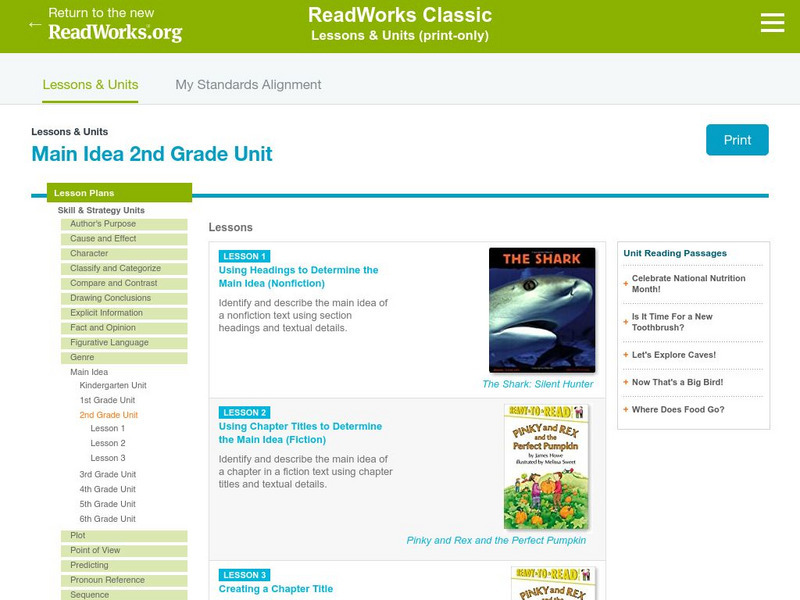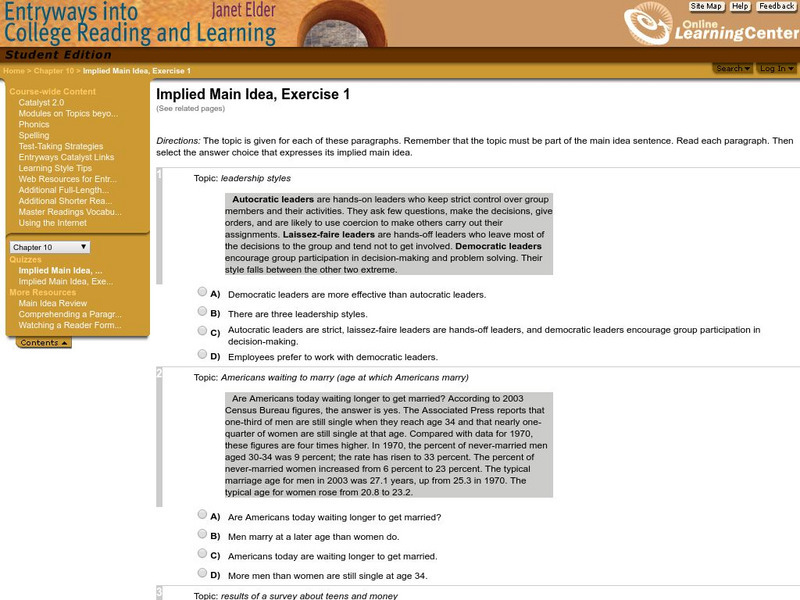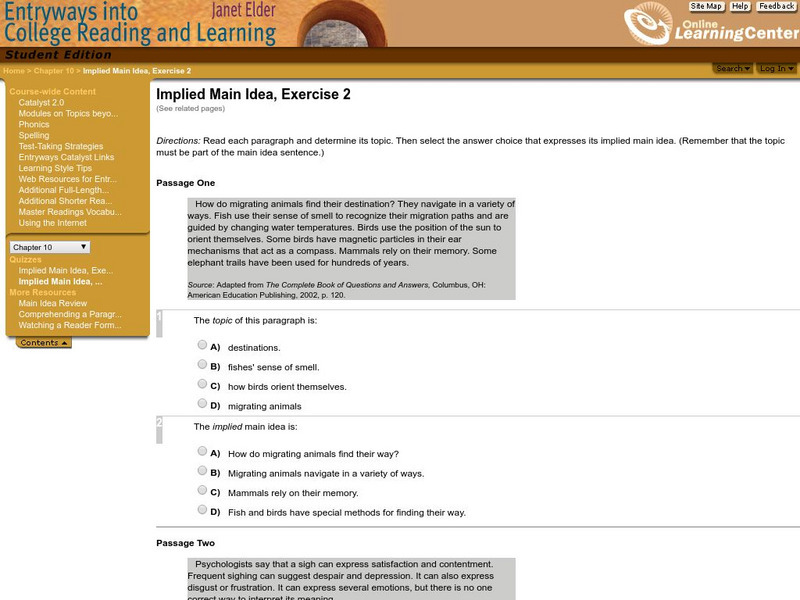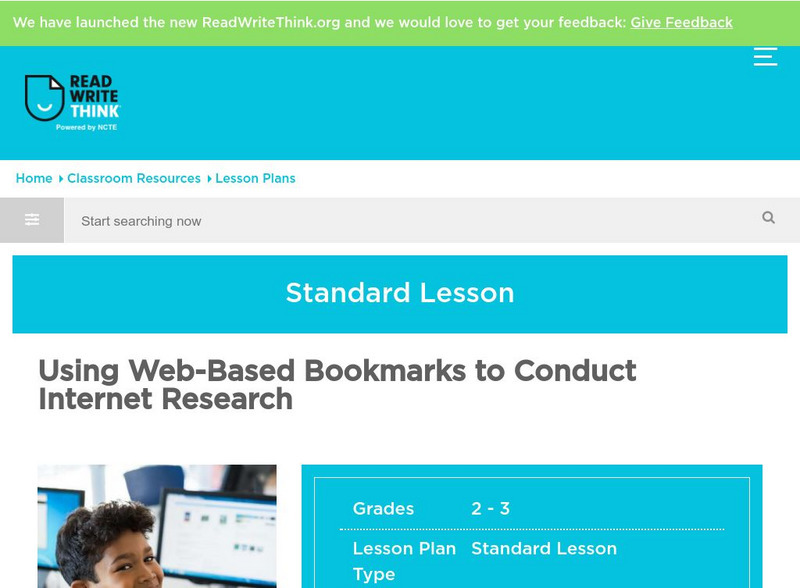Georgia Department of Education
Ga Virtual Learning: The Elements of Poetry [Pdf]
This is a 2-page PDF of a chart that lists eight elements of poetry, questions to ask concerning each element, and tips and explanations to aid the understanding of each element. RL.9-10.5 text structure effects
Read Works
Read Works: Grade 2: Three Lesson Unit: Main Idea
[Free Registration/Login Required] A series of three lesson plans designed to teach students to identify main ideas through headings and chapter titles, and then to write appropriate titles of their own. Lessons are based on the books...
E Reading Worksheets
E Reading Worksheets: Patterns of Organization: Compare and Contrast
This learning module provides an explanation of the compare and contrast text structure. An explanation of the compare and contrast text structure is provided, and the compare and contrast text structure is demonstrated in a video...
E Reading Worksheets
E Reading Worksheets: Patterns of Organization: Sequence
This learning module provides an explanation of the text structure for sequence. An explanation of the text structure for a sequence is provided, and chronological order text structure is demonstrated in a video tutorial lesson [1:24]
Wisconsin Response to Intervention Center
Wisconsin Rt I Center: Text Dependent Questions [Pdf]
Describes a reading strategy where students must respond to text by supporting their ideas with text-based evidence. Lists different categories of questions the teacher can prepare based on the text chosen, with examples for each.
Curated OER
Mc Graw Hill: Part 2 Reading: Informational Text: Connections Within Text
Learn how information in a text can be connected through compare and contrast, cause and effect, and sequence.
Curated OER
Mc Graw Hill: Use Details and Examples
Review how to use text evidence, details, examples, and personal experiences to make inferences then read a passage to practice on your own.
Curated OER
Mc Graw Hill: Part 2 Reading: Determine Main Idea and Supporting Details
A reference article for students to learn about how to determine the main idea and supporting details from the text. Click on the Model for an example with explanation and then click on Practice for a practice exercise.
Curated OER
Mc Graw Hill: Part 2 Reading: Determine Main Idea and Supporting Details: Model
An example to guide students in choosing the main idea and supporting details. Click Practice for a practice quiz.
Curated OER
Mc Graw Hill: Part 2 Reading: Informational Text: Compare Perspectives
Learn about the difference between a firsthand and secondhand accounts in a text on this site.
Curated OER
Mc Graw Hill: Part 2 Reading: Determine Main Ideas and Supporting Details
See how to pick out the main ideas and supporting details on this site. Click on Model at the bottom right.
Curated OER
Mc Graw Hill: Part 2 Reading: Determine Main Ideas and Supporting Details
See an example of how to determine the main ideas and supporting details of a story.
Curated OER
Mc Graw Hill: Structure Within a Story
Learn why structure is important when organizing a story then read an excerpt from the story "Three over Four" to practice how structure helps to develop the story's theme, setting, and plot.
E Reading Worksheets
E Reading Worksheets: Patterns of Organization: Order of Importance
This site provides an explanation of the order of importance text structure. A diagram is provided to provide to supplement the explanation.
Grammarly
Grammarly Handbook: Patterns of Organization for Academic Texts
A list of six different ways to organize a text with links to more information for each.
Curated OER
Mc Graw Hill: Part 2 Reading: Informational Text: Analyze Multiple Accounts
Learn about the different perspectives that can be used in an informational text.
McGraw Hill
Mc Graw Hill Global Education: Implied Main Idea, Exercise 1
Take this five question self-correcting quiz to test your understanding of the implied main idea.
McGraw Hill
Mc Graw Hill Global Education: Implied Main Idea, Exercise 2
Take this five-question self-correcting quiz to test your understanding of the implied main idea.
ReadWriteThink
Read Write Think: Using Web Based Bookmarks to Conduct Internet Research
The important thing about this instructional activity is that it connects literature and science. The Important Book by Margaret Wise Brown provides a model for original student poems about a content area topic. Web-based bookmarks guide...
Other
Suny: Conventions of Writing Papers About Literature
A professor's excellent explanation of how to write a professional sounding essay. Covers all aspects of an essay, and detailed examples give information on exactly how to write the essay.
ReadWriteThink
Read Write Think: Exploring How Section Headings Support Understanding
Teaching students to pay attention to headings and titles as they read? Here you'll find a practical application for using an expository text to apply the concept of using headings. Geared toward older elementary students, but lesson...
ReadWriteThink
Read Write Think: Exploring Character, Conflict, and Plot in Dramatic Tragedy
Contains plans for four lessons that ask students to change the action in the turning point of a tragedy in order to see the effect on the rest of the play. In addition to objectives and standards, this instructional plan contains links...
Other
Georgia Perimeter: Choosing and Writing for an Audience
This resource goes extensively into the importance of establishing an audience when writing. It also defines types, how to choose, and how to write for an audience.
Curated OER
Mc Graw Hill: Part 2 Reading: Informational Text: Compare Text Structures
Compare the text structures in two nonfiction passages in this tutorial.


![Ga Virtual Learning: The Elements of Poetry [Pdf] Graphic Ga Virtual Learning: The Elements of Poetry [Pdf] Graphic](https://d15y2dacu3jp90.cloudfront.net/images/attachment_defaults/resource/large/FPO-knovation.png)









